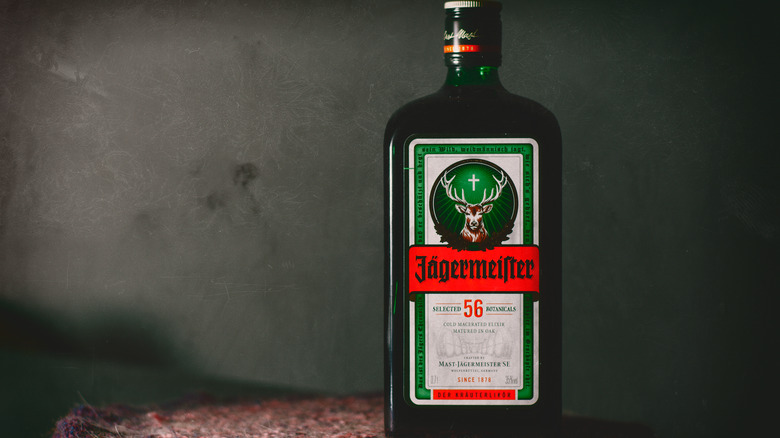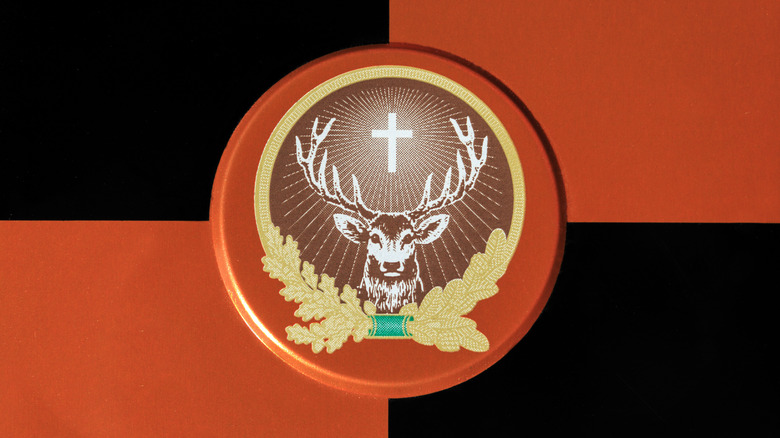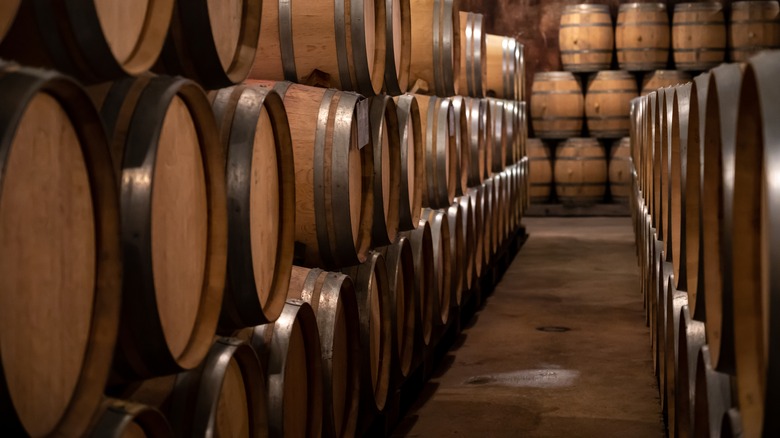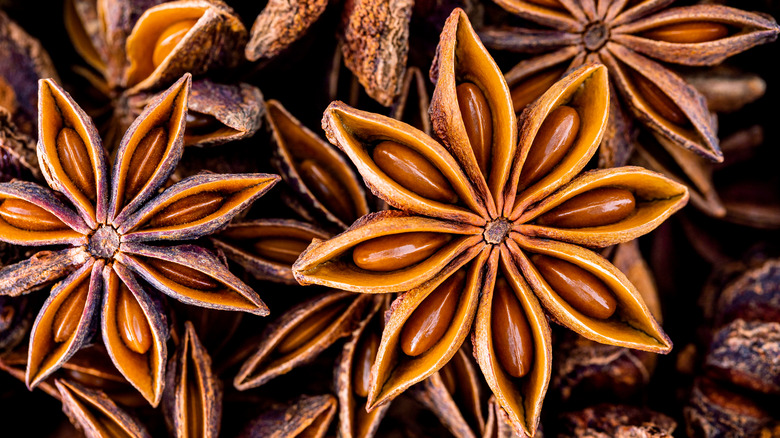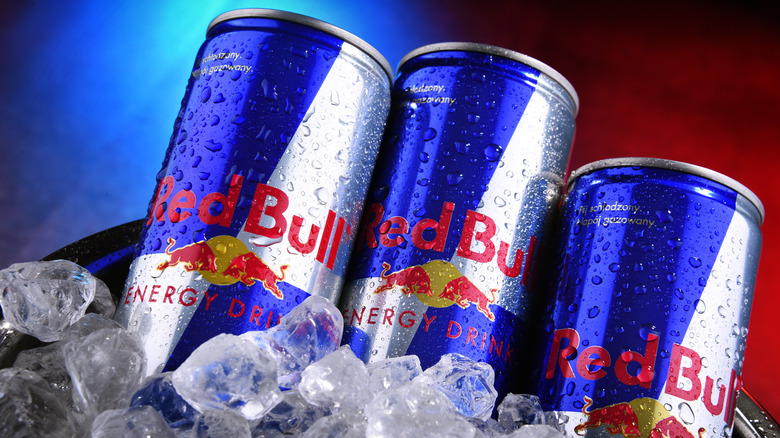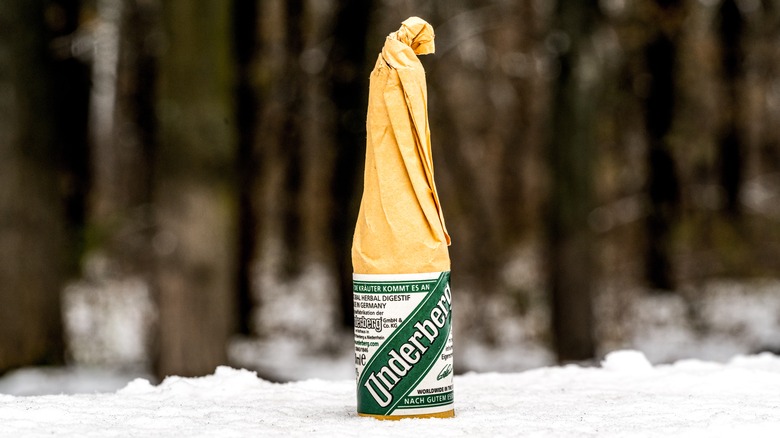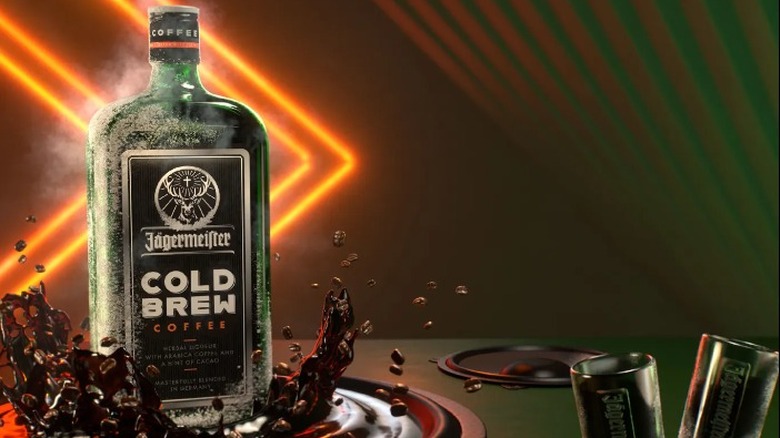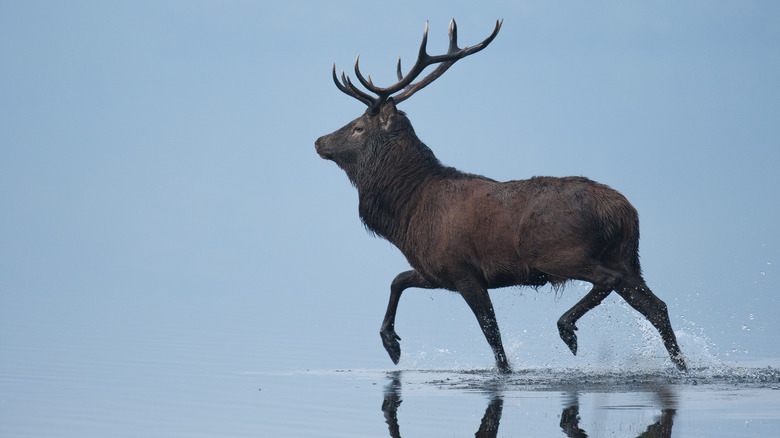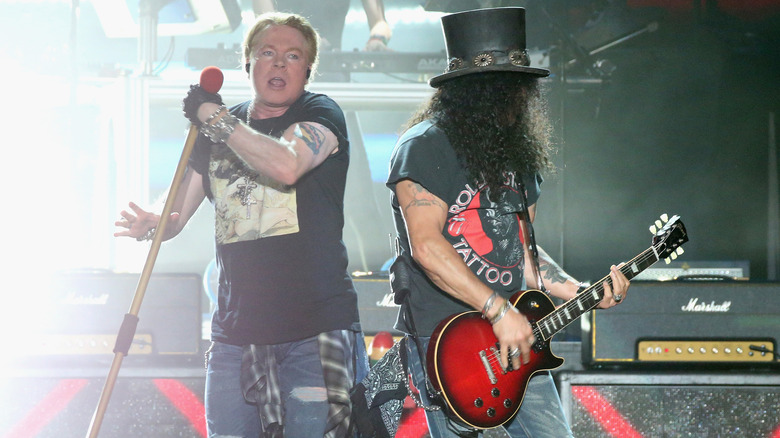Jägermeister: The Ultimate Bottle Guide
Germany may not be the first country that comes to mind when one thinks about digestifs, but believe it or not, Germany is home to many distilleries known for world-class after-dinner drinks. Digestifs are liqueurs that "have been used for thousands of years in cultures across the globe to either calm or stimulate the gastrointestinal system," as Stephen Fromhart, owner of Amaro Spirits & Wine, explained to Martha Stewart. These bitter, herbaceous libations come in many forms including brandy, fortified wines, and distilled liqueurs. One of the most popular brands is a bottle you might just have at home in your liquor cabinet: Jägermeister.
Jägermeister, affectionately nicknamed Jäger, was originally billed as a medicinal product used to help with coughing, digestion, and a whole host of other ailments. It has a relatively high alcohol content for a liqueur at 35% alcohol by volume. The brand's proprietors have kept the full recipe close to their chests since its inception, but the distillery publicly discloses several herbs, spices, roots, and citrus ingredients that are used in the making of Jägermeister and are responsible for its sweet, spicy, and bitter flavor profile.
While it's perfectly acceptable to drink it neat, Jägermeister can be mixed with any number of beverages for a sweet-and-spicy twist. Although it originated as a botanical beverage for outdoorsmen, it's now popular with partygoers, classy cocktail drinkers, and casual consumers all over the world. The brand has steadily grown in popularity despite the presence of countless other digestifs available on the market today — in fact, it reported an all-time sales record in 2021, according to The Moodie Davitt Report.
History of Jägermeister
Jägermeister was officially invented by Curt Mast in 1934. But our story begins with Curt's father, Wilhelm Mast, who established a family vinegar factory in the quiet town of Wolfenbüttel, Germany in 1878 (according to Mast-Jägermeister). Curt grew up helping his father around the factory but had separately developed a passion for wine and liqueurs. In the early 20th century, Curt took over the struggling business from Wilhelm and shifted the operation's focus to the production of spirits in order to alleviate the debt the factory had accrued. It took tedious years of toying with ingredients for Curt to concoct the potion that would become Jägermeister and the recipe has not been changed since.
An avid outdoorsman and hunter, Curt wanted his botanical liqueur to convey the spirit of the great outdoors. He went literal: The name "Jägermeister" translates to "hunting master." For the iconic stag and cross logo, Curt was inspired by Saint Hubertus (the patron saint of hunters), who according to legend, saw the vision of a crucifix miraculously appear between the antlers of a mighty stag while hunting, leaving him with a massive appreciation and respect for nature (via International Order of Saint Hubertus). The bottle itself is a product of practicality — Curt desired a bottle shape that would hold up with his rough-and-tumble hunting buddies in the woods. To find the perfect bottle design, Curt took home a variety of bottles and dropped them on the floor until he found one that didn't break — the iconic square bottle still used by the Jägermeister distillery today.
How is Jägermeister made?
There are a whopping 56 ingredients used in the production of Jägermeister, and they're the exact same ingredients Curt Mast discovered all the way back in 1934. It takes over a year for the highly-trained master distillers to produce the aromatic digestif. To start, each ingredient is weighed and ground with different mills to achieve the desired texture. The weighed and ground dry ingredients are then put through maceration; a process in which a solution of alcohol and water is added to the dry mix.
The herb mixture is allowed to steep in the alcohol and water solution for several weeks, which facilitates the dissolving of the herbs and helps the liquid concoction absorb and extract the botanicals' essential flavors and oils. Once steeped, the remains become base material, which is stored in 445 massive oak barrels for an entire year after the first filtration. During this stage, the base material slowly but surely absorbs some of the flavors of the oak barrels while it matures.
The real magic happens when the base material's year in the oak barrels is up. It's then filtered a second time, mixed with the remaining liquid ingredients, and then filtered again. Before being poured into steel tanks and brought to the bottling factory, the final product is analyzed by a laboratory to ensure consistency across products before final approval.
What does Jägermeister taste like?
This should come as a surprise to absolutely no one, but 56 distinct ingredients make for quite an elaborate bouquet of flavor. Jäger's master distillers are the only people privy to the top-secret ingredient list, but their website confirms several of the key additives: star anise, cinnamon, licorice root, bitter orange, chiretta, orange peel, ginger, galangal, clove, mace, and cardamom. Many of these ingredients contribute to the aromatic liqueur's sweet but spicy flavor. A Couple Cooks explains its taste as "most similar to an Italian amaro (bitter liqueur) like Amaro Nonino." The digestif is often described as tasting like black licorice, star anise, and root beer (although surprisingly, the flavor of root beer comes from sassafras and sarsaparilla — neither of which are confirmed ingredients in Jägermeister).
Because of their uniquely sweet and pungent spicy taste, bitter digestifs like Jägermeister are not universally beloved. The licorice aroma can be a tough sell for those who prefer a straightforward flavor in their drinks. However, consumers who enjoy herbaceous, aromatic cocktails — like Manhattans, Boulevardiers, or Negronis — are likely to find an appreciation for the complex flavor of Jägermeister.
How to drink Jägermeister
The Jägermeister website recommends enjoying it at around 0 degrees Fahrenheit — the temperature a home freezer typically sits at. As Willy Shine, Jägermeister's Brandmeister, explains: "If you drink it ice cold ... it tightens up and it pushes forward the cinnamon and the clove and the licorice and the star anise. It becomes slightly viscous because it's ice cold and coming out of the tap machine." Store the bottle in the freezer whenever you're not actively using it.
It's perfectly fine to drink Jägermeister neat, but again, the strong taste can be off-putting to some palates. Many people prefer to incorporate it into a mixed drink. There are many drinks that can be mixed with Jägermeister for an absolutely delicious result, ranging from other alcoholic beverages like beer to spicy sodas like ginger beer.
One of the most popular combos results in a Jäger bomb, which was invented in 1997 in either North or South Lake Tahoe (it's quite a debate, as Slideshow Pete reports). Typically made with half of a can of Red Bull and a shot of Jäger, Jäger bombs were named for the eruption that occurs when the shot is dropped into the energy drink. They're a longtime favorite at frat parties, but bear in mind that mixing energy drinks with alcohol can lead to risky behaviors (per the CDC). That's not to say Jäger bombs are out of the question — just remember to imbibe responsibly.
Jägermeister versus Underberg
Falling into the category of bitter liqueurs, Jäger has its own distinct recipe and flavor profile — but it does have competitors. Drinks International points out that the popularity of many big-name digestif brands (Araucano, Unicum, and Gammel Dansk, for example) extends only to the regions in which those liqueurs are distilled. Touting impressive international presences and cult followings around the world, Jägermeister and Underberg are two of the most dominant names in the bitters world.
Underberg, another German digestif produced in Rheinberg, was created in 1846 — nearly a century before Jägermeister hit the market. Just like Curt Mast, the founders of Underberg originally marketed it as a health tonic and have also kept the recipe top secret. Only those who personally oversee production know about the precise mixture of ingredients used to manufacture the drink. Underberg has a higher alcohol content at 44% ABV (Jäger has 35%) and is made with a selection of botanicals, herbs, and roots sourced from 43 different countries. Like Jäger, Underberg has a strong anise or licorice taste (as Tales of the Cocktail reports) — but its consistency is said to be thicker than that of Jägermeister and is less sweet. Though Underberg is available in the United States, Jägermeister has proven to be the favorite amongst North Americans.
Jägermeister has expanded beyond their original bottle
The original Jägermeister — the standard green bottle we all know today — is the manufacturer's most popular product. But Jägermeister actually produces several spin-off beverages that are available around the globe. Coffee drinkers will love their Jägermeister Cold Brew Coffee (try Jägermeister coffee and chocolate for a boozy after-dinner treat!). It's brewed with Arabica coffee beans and is available in both full-sized 750-ml bottles and more portable 20-ml cold brew coffee shots (perfect for portioning out shots or sticking into a gift bag for caffeine-loving friends).
A lesser-known option is Jägermeister Manifest, a high-end bottle for special celebrations. Manifest is based on the same original 56 ingredients that comprise the Jäger classic and is billed as "the world's first super premium herbal liqueur" by Mast-Jägermeister. Manifest packs a slightly boozier punch than its original counterpart (37% ABV) and is aged in oak barrels for 15 months (versus the traditional Jäger's 12). The longer aging process is said to infuse the liquor with intriguing notes of smoke and vanilla.
Jäger was rumored to contain stag's blood
The world has long speculated about the secret recipe behind Jägermeister. Though several key ingredients have been revealed, the majority remain a mystery. However, as early as 1992 (according to Snopes), rumors have circulated about the possibility of a particularly morbid ingredient supposedly added to the aromatic liqueur: elk or deer blood. The origins of the legend are unclear, but the story likely spawns from the dark color of the liquid and the stag-and-cross logo. Jägermeister was, after all, heavily marketed as a drink for hunters, and it's possible that the brand's marketing team surreptitiously capitalized on the literal translation of the name ("hunting master") and quietly spread the spooky tale to boost liquor sales.
For the record, Jägermeister has steadfastly denied any claims that their digestif contains stag's blood — in fact, it is completely vegan, meaning there are no animal products or byproducts present in the finished bottle. While the deer blood legend adds a layer of mystique to the already fascinating legend of Jägermeister, it's a tall tale best told around the campfire with friends, a bottle of Jäger, and some ice-cold beer.
Guns N' Roses are huge Jägermeister fans
Jägermeister has an impressive following among some of the biggest names in rock 'n' roll, but Guns N' Roses just might be the brand's most enthusiastic aficionados. They've mentioned their love for the drink in many interviews and the connection is even mentioned in "The Best Nights of Your Life: The Original Jägermeister Book," a collection of stories about Jäger-fueled exploits from celebrities and fans of the drink from around the world. In 2018, when asked about how he staves off burnout on the road, Guns N' Roses keyboardist Dizzy Reed simply replied "Jägermeister" (per "Nothing Shocking" podcast as transcribed by Blabbermouth).
Guns N' Roses' love for the drink is widely known, but they took things to a whole new level back in November of 2006. The band was rehearsing for a concert in Portland, Maine when fire marshals arrived for a safety check on the pyrotechnics for the show. They informed the band that they were prohibited from drinking alcohol of any kind onstage (a spokesperson for the Maine Public Safety Department told Today that the group had reportedly planned on drinking beer, wine, and Jägermeister during the show). In true rock 'n' roll fashion, Guns N' Roses canceled the concert and told the press that the state officials' alcohol ban made it "impossible for the band to perform their show to the usual high standards that their fans deserve."
Jägermeister was the first brand to sponsor a professional sports team
Nowadays, it's commonplace for large corporations to sponsor professional sports teams. But up until the 1970s, jersey advertising was nonexistent. Believe it or not, it was none other than Jägermeister who paved the way for corporate sponsorships in sports. According to The Football Times, in 1972, Jäger's then-CEO Günter Mast realized the untapped potential for advertising in European football. But at the time, Germany forbade companies from advertising on football (soccer) jerseys.
Mast pitched his idea for jersey advertising to the German Football Association (DFB) and was immediately vetoed, but he kept at it. After a highly publicized legal battle and an agreement to pay the DFB a sum of 100,000 German Marks, he finally persuaded the association to allow Jägermeister's famous stag logo on the Eintracht Braunschweig soccer team's uniforms. The stag logo remained on the Braunschweig team's shirts until 1987 when the league went back to its original logo featuring a lion. Still, Mast's realization of the potential for advertising on shirts and his tenacity in his battle to have the stag emblazoned on the Braunschweig athletes' jerseys marked a giant leap in the world of corporate advertising in sports. In the years since, Jäger went on to partner with countless other sports clubs, companies, and leagues including American football, bobsled, motorsports, and most recently the National Hockey League.
Jäger supports the nightlife community
When the Covid-19 pandemic turned the world upside-down in 2020, restaurants, bars, dance clubs, and entertainment venues around the globe were forced to shut down and tens of thousands of workers in the entertainment industry found themselves suddenly unemployed. Recognizing the importance of the nightlife community to their brand, Jägermeister rushed in to help by creating #SAVETHENIGHT, a campaign designed to help both creatives and nightlife staff during that difficult time.
#SAVETHENIGHT kicked off with what Jäger dubbed "Meister Drop-Ins" and "Meister Masterclasses" — programs in which their stuck-at-home audience could book virtual sessions with "Meisters" (entertainers, cocktail connoisseurs, DJs, and more) who would drop in on participants' online gatherings for live DJ sets, cocktail-making classes, stand-up shows, and more. Meisters were paid directly by Jägermeister (the drop-ins and masterclasses were free for anyone to book) and could accept tips from their online audience. The campaign was revolutionary for the brand and in 2021, international superstar Post Malone headlined a short film to raise money for #SAVETHENIGHT (per Boss Hunting) and soon become the face of the crusade.
